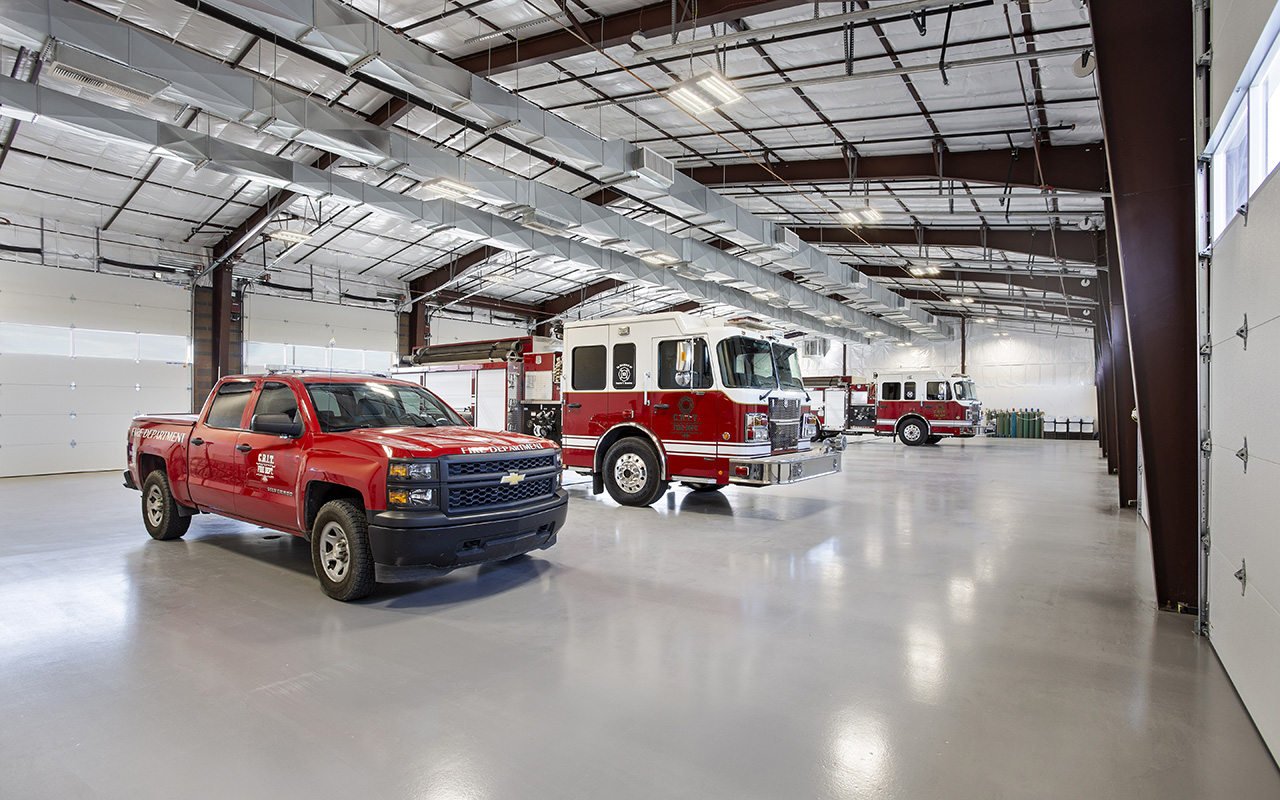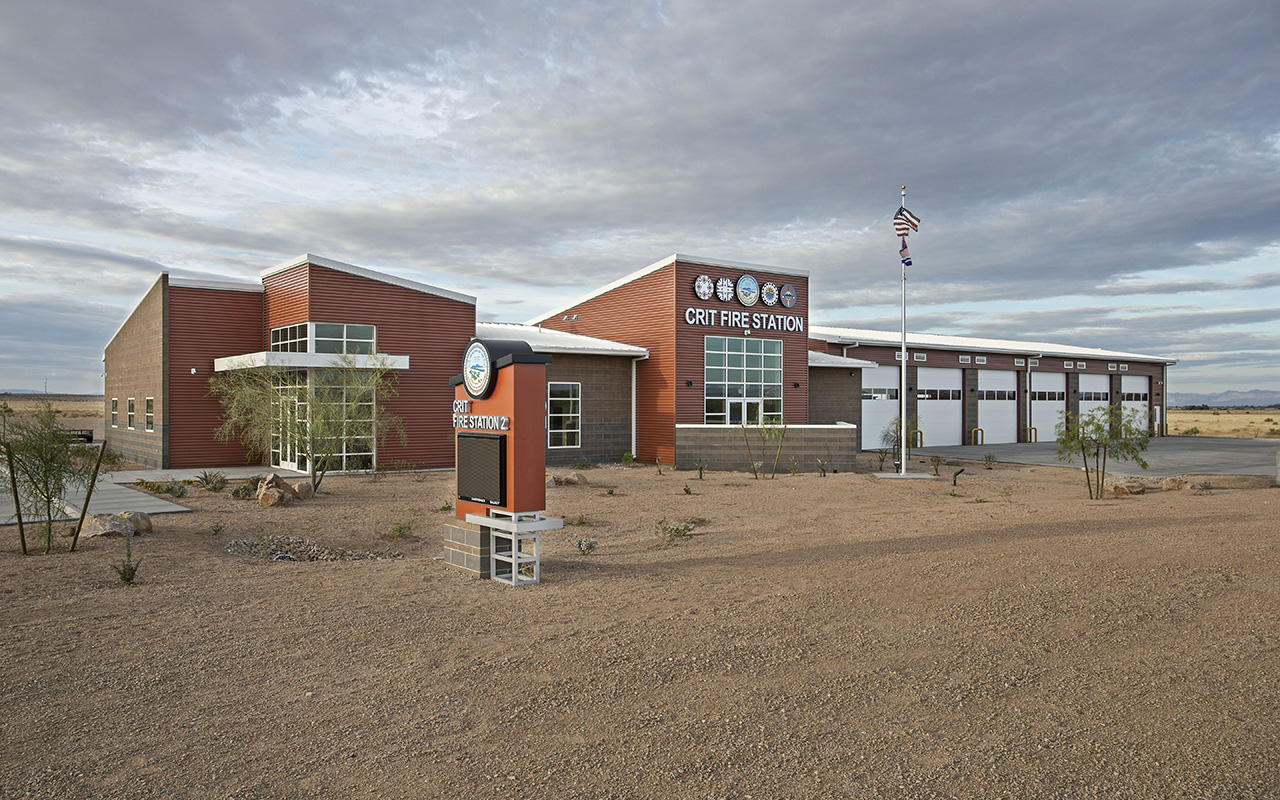The Reservation of the Colorado River Indian Tribes (CRIT), a federally recognized sovereign Indian tribe, extends to both the Arizona and California side of the majestic Colorado River. While the primary economic activity on the CRIT Reservation has always been agriculture, recent ventures into diversified businesses and tourism, including a new casino, have bolstered economic growth, thereby creating the need for a new state-of-the-art fire safety substation to serve the community.
Deemed a top priority by the CRIT Tribal Council, the vision for the facility was to meet current and future operational needs for at least the next decade, as well as to be a point of pride for CRIT community members. The resulting fire safety substation is a multifunctional facility that includes a fire station, administration space, community meeting rooms, crew quarters, an emergency operation center, triage and stabilization clinic and six apparatus bays.
The unforgiving desert temperatures, often in excess of 120 degrees Fahrenheit, not to mention year-round high winds and sandstorms (the area of the Western Arizona desert regularly sees wind speeds greater than 25 mph winds with gusts of 75 mph) created a unique challenge for the new construction’s project team, but environmental extremes were just one consideration. Additional factors such as a need to meet energy efficiency guidelines, a requirement for extreme durability and minimal long-term maintenance, as well as tight scheduling, called for a creative solution, one that combined a Star Building Systems custom-engineered steel structure and metal panels with conventional materials.
As Greg St. Clair, president of Tempe-based Arizona Corporate Builders LLC, explained in a Metal Architecture interview, “This project was a great example of the use of the [Star] custom pre-engineered steel structure along with a conventional concrete masonry unit (CMU) and wood structures to create an economical yet aesthetically pleasing architectural look. The architect [Stroh Architecture Inc.] was brilliant in his choice of multiple metal panels. The schedule of this project was definitely a big challenge. The use of the PEMB structure played a big part in providing a structure that was quick to erect. Extra consideration had to be taken to accommodate most the trades having to travel distances to perform on this project to be able to do their work with only one mobilization.”
Half of the building—the auxiliary portion for the fire engines and training areas—was a custom-engineered metal structure and the other half with all the offices and support areas was a conventional frame, all under one roof. Arizona Corporate Builders, which specializes in custom pre-engineered metal buildings, erected the metal structure that housed the apparatus bays, and installed the metal roof on the entire structure. Overall, Arizona Corporate Builders installed approximately 13,300 square feet of 24-gauge BattenLok® HS metal roof panels. Polar White was chosen for the standing seam roof to maximize reduction of solar heat gain. The further appeal of a standing seam roof here is
that it is a long-lasting and low-maintenance roof system for a relatively reasonable amount of money.

As to the benefits of the Star PEMB for this project, St. Clair remarks that economics, sustainability, durability, and flexibility all came into play, as well as aesthetics since Star was able to include the specific panels needed as part of its package. He explains:
“Generally speaking, a pre-engineered metal building is a more economical way to do structures, especially an open structure like this one where we had the need to fit the trucks in there with no columns inside getting in the way.” Although the other section of the building used concrete masonry and wood, Star was able to provide the roof sheeting portion of it so that it would all match. The designers wanted it to visually appear as one system. “It all runs together,” says St. Clair. “The masonry shows for architectural feature, and then there are some metal panels that match or are the same panels that go around the apparatus bay.”
Coordination with the architect was key as to how to attach the panels throughout the structure, especially given that the construction consisted of both a metal building system and other conventional materials. Different mechanisms or fasteners were needed to attach the panels and ensure they all looked cohesive.
From Star’s perspective, the project had a lot going on with it due to different angles, textured surfaces and color contrast. The Star system incorporated wind beam bracing instead of a conventional portal frame or X-bracing due to clearance requirements.
The well-received project, completed in February 2019, was a big success all around—with the result a distinctive and elegant design with reasonable construction costs and low long-term maintenance needs.
Colorado River Indian Tribes’ Fire Safety Substation, Parker, AZ
Completed: February 2019
Size: 13,327 square feet
Owner: Colorado River Indian Tribes of the Colorado River Indian Reservation, Arizona and California
General Contractor: Low Mountain Construction Inc., Phoenix, AZ
Architect: Stroh Architecture, Inc., Prescott, AZ
Erector/Installer: Arizona Corporate Builders LLC., Tempe, AZ
Metal Building System: Star Building Systems, Oklahoma City
Metal Roof Panels: MBCI, Houston
Related Stories
| Aug 11, 2010
AAMA leads development of BIM standard for fenestration products
The American Architectural Manufacturers Association’s newly formed BIM Task Group met during the AAMA National Fall Conference to discuss the need for an BIM standard for nonresidential fenestration products.
| Aug 11, 2010
9 rooftop photovoltaic installation tips
The popularity of rooftop photovoltaic (PV) panels has exploded during the past decade as Building Teams look to maximize building energy efficiency, implement renewable energy measures, and achieve green building certification for their projects. However, installing rooftop PV systems—rack-mounted, roof-bearing, or fully integrated systems—requires careful consideration to avoid damaging the roof system.
| Aug 11, 2010
Pella introduces BIM models for windows and doors
Pella Corporation now offers three-dimensional (3D) window and door models for use in Building Information Modeling (BIM) projects by architects, designers, and others looking for aesthetically correct, easy-to-use, data-rich 3D drawings.
| Aug 11, 2010
AAMA developing product-based green certification program for fenestration
The American Architectural Manufacturers Association is working on a product-based green certification program for residential and commercial fenestration, the organization announced today. AAMA will use the results of a recent green building survey to help shape the program. Among the survey's findings: 77% of respondents reported a green certification program for fenestration would benefit the product selection process for their company.
| Aug 11, 2010
Seven tips for specifying and designing with insulated metal wall panels
Insulated metal panels, or IMPs, have been a popular exterior wall cladding choice for more than 30 years. These sandwich panels are composed of liquid insulating foam, such as polyurethane, injected between two aluminum or steel metal face panels to form a solid, monolithic unit. The result is a lightweight, highly insulated (R-14 to R-30, depending on the thickness of the panel) exterior clad...
| Aug 11, 2010
AIA Course: Enclosure strategies for better buildings
Sustainability and energy efficiency depend not only on the overall design but also on the building's enclosure system. Whether it's via better air-infiltration control, thermal insulation, and moisture control, or more advanced strategies such as active façades with automated shading and venting or novel enclosure types such as double walls, Building Teams are delivering more efficient, better performing, and healthier building enclosures.








